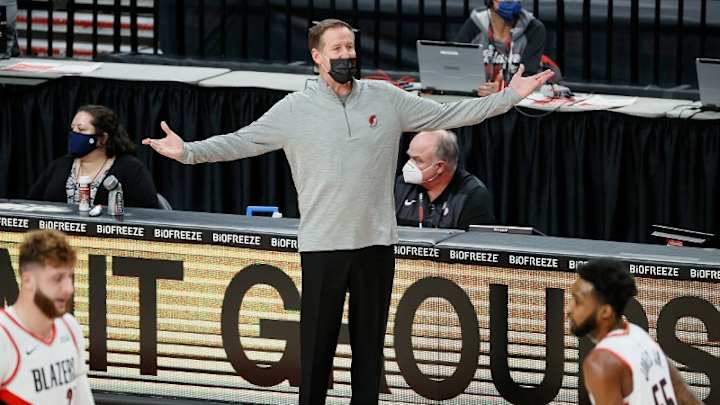The Blame For Portland's Lack of Ball Movement Doesn't Lie With Coaching

The Trail Blazers won where they were supposed to on Saturday night, outscoring the Wizards by a whopping 39 points from beyond the arc. Their 19 triples tied for the fourth-most in a game this season, while Washington's six made threes tied for the fewest Portland has allowed.
Needless to say, that's the type of math that normally ensures victory in the modern NBA. But the Blazers' six-game winning streak came to an end regardless, as they were beset by wildly inconsistent offense that proved most punchless late, when the outcome hung in the balance.
Asked what he'd communicate to his players so Portland avoids those offensive ebbs and flows, Terry Stotts preached trust and patience above all else.
"Trust each other. Don't try to do it all by themselves. Create opportunities for each other," he said. "Play a little bit harder on defense so maybe you get some opportunities in transition and flow."
Good ideas! The problem is that the Blazers' personnel, even more than in past years, doesn't lend itself to them being implemented – whether by specific design or in random flow of the offense.
Portland's 48.9 assist percentage ranks last in the league by a wide margin. With Jusuf Nurkic and C.J. McCollum out, that share of assisted baskets dips all the way down to 44.9 percent, per NBA.com/stats.
The Blazers' reliance on ball-dominant guards who do most of their work in pick-and-roll and isolation has for years put them at or near the bottom of the league in assists. It's not like that trend has prevented Portland from putting together elite offenses. Stotts' team was top-three in offensive rating each of the last two years, and currently ranks sixth.
But with McCollum and Nurkic out, the Blazers are absent not just their two best passers other than Damian Lillard, but their two players who most pressure defenses other than Lillard, too.
Is it really surprising lineups featuring Carmelo Anthony, Gary Trent Jr. and Anfernee Simons assist on barely a quarter of their scores? What are they doing that causes the defense to rotate, creating opportunities for ball movement that culminate in open shots? And on the possessions Anthony gets a double-team in the post or two defenders converge on Trent after a dribble hand-off, what are the chances they take advantage with the pass rather than call their own number?
"Ironically, obviously when you don't make shots you don't get assists," Stotts said, "but we had 10 assists in the first quarter and no assists in the second quarter."
Related: Lillard, treated by Washington's defense like a five-alarm fire, spent the first seven minutes of the second quarter on the bench, watching as the second unit barfed up possessions like below.
It's tempting to blame coaching for the second unit's lack of ball movement and overall offensive verve.
Portland ranks bottom-10 in possessions finished by cut, and 28th in transition frequency, per NBA.com/stats. Designing more player movement and emphasizing pace would would naturally goad the Blazers' shoot-first reserves into a more egalitarian offensive approach, right?
Maybe, but defenses don't react to staid, deliberate motion alone. Deploying a movement-based offense like Miami's wouldn't turn Trent and Simons into bubble Duncan Robinson and Tyler Herro. Running simply for the sake of doing so doesn't create efficient offense; Houston's eighth-ranked percentage of time in transition isn't actually adding anything when it scores a meager 1.04 points per possession.
The elephant in the room here is obvious. It goes without saying that replacing Anthony in the rotation with Nassir Little would provide the Blazers a jolt of athleticism and activity, and most importantly, rid the second unit of the player most responsible for its "your turn, my turn" offensive ethos. '
Anthony's minutes aren't going anywhere, though, and neither is an iso-heavy style that helped propel him to the Hall of Fame. The hope is that his role lessens when Portland gets healthy, with Anthony taking a backseat offensively in second units being run by McCollum. Fingers crossed, but it's telling that the Blazers are still feeding Anthony touch after touch as Trent and Simons show major developmental growth.
The likeliest fix is the one most convenient for all involved: time. Portland won't rely quite so much on the three when McCollum and Nurkic are healthy, ensuring scoring droughts like Saturday's end more quickly. Defenses won't be so keen on selling out to stop Lillard with McCollum and Nurkic in the lineup, either – or at least more often pay for it when they do.
Most offenses would have been dead in the water without their second and third best players. It's a major testament to not just Lillard and his teammates, but also Stotts and his coaching staff, that the Blazers' awesome offense of late made the struggles against Washington seem so surprising.
